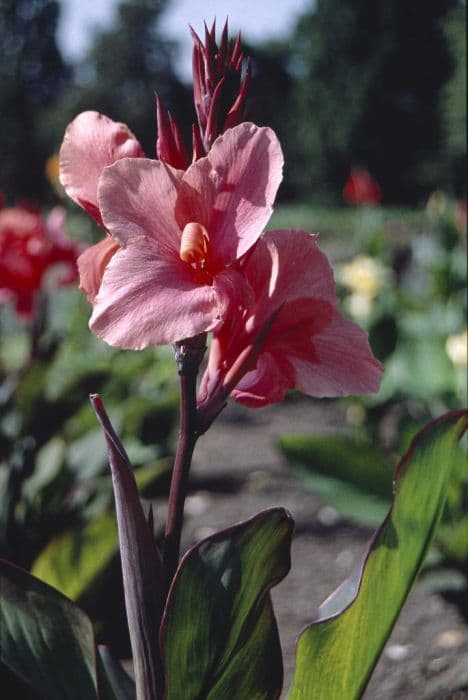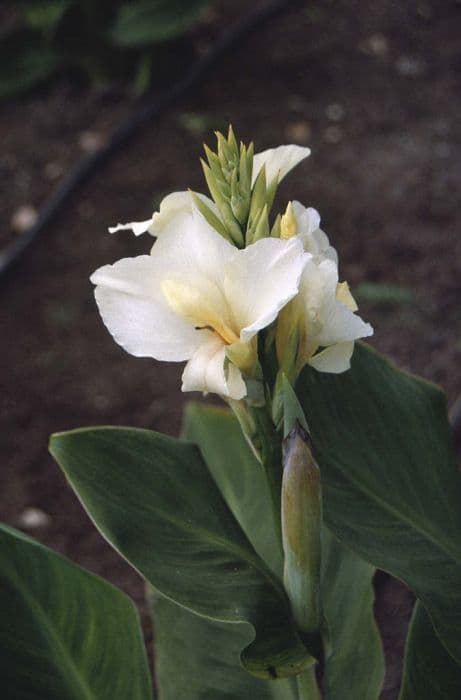Canna Lily Canna 'Whithelm Pride'

ABOUT
Canna 'Whithelm Pride' is notable for its large, lush, and tropical-looking foliage which is typically green, sometimes showcasing hints of bronze or maroon. The leaves are broad and paddle-shaped, creating a dramatic and dense leafy display. This ornamental beauty blooms with striking flowers that add a bold splash of color to the plant. The blooms are typically radiant and may come in various hues such as yellow, orange, or red, often with distinctive speckles or streaks. Each individual flower is large and iris-like in shape, with flaring petals that can give the plant a somewhat exotic allure. These blossoms form on tall flower spikes that rise above the foliage, adding to the plant's visual interest. The overall appearance of Canna 'Whithelm Pride' is that of a robust, vibrant plant with a tropical flair, making it an attractive choice for gardeners looking to add a touch of the exotic to their landscapes.
About this plant
 Names
NamesFamily
Cannaceae.
Synonyms
Canna Lily, Canna.
Common names
Canna 'Whithelm Pride'
 Toxicity
ToxicityTo humans
Canna lilies, including the variety 'Whithelm Pride', are generally considered non-toxic to humans. They do not typically pose a threat if touched or ingested in small quantities. However, as with any plant, individual allergic reactions could occur, so it's prudent to exercise common caution. There are no commonly reported symptoms of poisoning from canna lilies because they are not known to be poisonous to humans.
To pets
Canna lilies, including the 'Whithelm Pride' variety, are also generally considered non-toxic to pets, including cats and dogs. They are not known to cause serious illness or symptoms of poisoning if pets consume parts of the plant. Always observe your pet for any unusual behavior after ingestion and consult a veterinarian if any concerns arise. However, the likelihood of a pet experiencing toxicity from canna lilies is low.
 Characteristics
CharacteristicsLife cycle
Perennials
Foliage type
Deciduous
Color of leaves
Varies
Flower color
Varies
Height
3-4 feet (0.9-1.2 meters)
Spread
1-2 feet (0.3-0.6 meters)
Plant type
Bulb
Hardiness zones
Varies
Native area
South America
Benefits
 General Benefits
General Benefits- Attractive Foliage: Canna 'Whithelm Pride' has large, tropical-looking leaves that add lush greenery and a unique texture to garden spaces.
- Vivid Blooms: It boasts striking flowers which can add a splash of color to any landscape, making it a popular choice for ornamental gardening.
- Easy to Grow: This plant is known for being low-maintenance and easy to cultivate, making it suitable for gardeners of all skill levels.
- Rapid Growth: It grows quickly and can reach full size in a single growing season, providing immediate impact in the garden.
- Drought Tolerance: Once established, it can tolerate periods of drought, which makes it suitable for gardens in dryer climates or for water-wise gardening.
- Pest Resistance: It's generally resistant to pests, reducing the need for chemical interventions and making it a more sustainable option.
- Privacy Screen: Due to its height and dense growth, it can be used to create privacy screens or as a backdrop for other plants in a garden bed.
- Seasonal Interest: Canna 'Whithelm Pride' offers long-lasting flowers throughout the summer until the first frost, providing sustained visual interest.
 Medical Properties
Medical PropertiesThis plant is not used for medical purposes.
 Air-purifying Qualities
Air-purifying QualitiesThis plant is not specifically known for air purifying qualities.
 Other Uses
Other Uses- Canna 'Whithelm Pride' can be used as a natural pest deterrent, as they can attract beneficial predators that help control garden pests.
- The plant's dried stalks can be fashioned into musical instruments such as flutes, especially in traditional crafts.
- Leaves from the Canna plant may be used as a biodegradable food wrapping, similar to banana leaves in some cuisines.
- Fibers from Canna 'Whithelm Pride' can be processed and used to make a rough form of paper or incorporated into handcrafted papers.
- The seeds of Canna have been used as beads in jewelry making due to their hard and durable nature.
- Larger leaves of the plant can serve as natural plates or placemats for outdoor dining events.
- Starch extracted from Canna 'Whithelm Pride' rhizomes can be used in the manufacture of bioplastic as a sustainable material.
- Canna 'Whithelm Pride' can be used in dye production, as parts of the plant may yield colorants for textiles or inks.
- The robust stems can be utilized as a natural fiber for weaving baskets or crafting other woven items.
- The plant's flowers can be added to potpourri mixes for their color and potential subtle fragrance.
Interesting Facts
 Feng Shui
Feng ShuiThe Canna is not used in Feng Shui practice.
 Zodiac Sign Compitability
Zodiac Sign CompitabilityThe Canna is not used in astrology practice.
 Plant Symbolism
Plant Symbolism- Confidence: The Canna 'Whithelm Pride', known simply as Canna, often symbolizes self-assuredness due to its bold colors and stature.
- Patriotism: Given its vibrant hues, Canna can represent love and devotion to one’s country, as it stands out much like a national flag.
- Beauty: The aesthetic appeal of Canna flowers, with their large and showy petals, signifies natural beauty and splendor.
 Water
WaterCanna lilies, including the 'Whithelm Pride', prefer consistently moist soil but don't fare well in standing water. Water them thoroughly to keep the soil evenly moist, especially during dry spells. As a general rule, aim to provide about 1 to 2 gallons of water per week, depending on the weather conditions; they may require more frequent watering during periods of high heat or drought. During the cooler months or when rainfall is plentiful, watering can be reduced. Always check the top inch of soil for dryness before watering to prevent overwatering.
 Light
LightCanna lilies thrive in full sun, which means at least 6 hours of direct sunlight a day. The ideal spot for a 'Whithelm Pride' canna lily is an area with unfiltered sunlight that encourages the most robust growth and vibrant blooms. Partial shade is tolerable, especially in the hottest parts of the day, but may result in fewer flowers and less vigorous plants.
 Temperature
TemperatureCanna lilies prefer warm temperatures and do not tolerate cold well. The 'Whithelm Pride' canna lily can survive in temperatures as low as 55 degrees Fahrenheit but grows best in conditions between 70 and 90 degrees Fahrenheit. They should be protected from frost, which means they may need to be moved indoors or provided with protection if temperatures are expected to drop below 55 degrees Fahrenheit.
 Pruning
PruningPruning is necessary for canna lilies mainly to remove spent flowers and damaged leaves, which encourages further blooming and maintains the plant's appearance. For 'Whithelm Pride' canna lilies, deadhead the old flowers to promote new ones and cut back any damaged or diseased foliage as needed. After the first frost in fall, cut back the foliage to a few inches above the ground to prepare for winter. Pruning is typically done on an as-needed basis throughout the growing season.
 Cleaning
CleaningAs needed
 Soil
SoilThe Canna Lily prefers a rich, moist, and well-draining soil mix with added organic matter like compost or manure. A slightly acidic to neutral pH, ranging from 6.0 to 6.5, is ideal for optimal growth.
 Repotting
RepottingCanna Lilies should be repotted every 2 to 3 years, or when they become pot-bound and outgrow their current container.
 Humidity & Misting
Humidity & MistingCanna Lilies thrive in high humidity environments, so aim for a relative humidity level of around 60-70%.
 Suitable locations
Suitable locationsIndoor
Place in bright light, keep soil moist, and ensure high humidity.
Outdoor
Plant in warm, well-draining soil with full to partial sun.
Hardiness zone
7-11 USDA
 Life cycle
Life cycleCanna 'Whithelm Pride', commonly known as Canna Lily, begins its life cycle as a dormant rhizome, which sprouts in early spring when temperatures warm up. The rhizomes produce shoots that grow into large, paddle-shaped leaves, creating a lush, tropical foliage. Throughout the summer, the Canna Lily produces tall flower stalks with vibrant, showy flowers that attract pollinators such as bees and hummingbirds. After the flowering period, the plant sets seed if pollination has occurred, though many cultivars are sterile and do not produce viable seed. Towards the end of the growing season in late summer or early fall, the foliage dies back as the plant enters dormancy. The rhizomes can be overwintered in the ground in warmer climates or dug up, stored, and replanted the following spring in cooler regions.
 Propogation
PropogationPropogation time
Spring to Summer
Propogation: Canna 'Whithelm Pride', commonly known as a variety of Canna Lily, can be best propagated through the division of its rhizomes. This process is ideally done in the spring as the plants are coming out of dormancy, or in the fall after the foliage has died back, enabling the plant to establish itself and become hardy before either the growing or dormant season. To propagate by division, carefully lift the Canna Lily clump out of the ground using a spade or fork, avoiding damaging the rhizomes. Then using a sharp, clean knife, divide the clump into smaller sections, ensuring that each division has at least one growth bud or eye. These divisions can then be replanted in well-draining soil, spaced approximately 1 to 2 feet apart to accommodate future growth. It's crucial to water the newly planted divisions regularly to encourage establishment.









